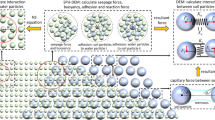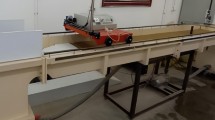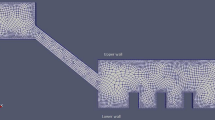Abstract.
Aeolian sand dunes originate from wind flow and sand bed interactions. According to wind properties and sand availability, they can adopt different shapes, ranging from huge motion-less star dunes to small and mobile barchan dunes. The latter are crescentic and emerge under a unidirectional wind, with a low sand supply. Here, a 3d model for barchan based on existing 2d model is proposed. After describing the intrinsic issues of 3d modeling, we show that the deflection of particules in reptation due to the shape of the dune leads to a lateral sand flux deflection, which takes the mathematical form of a non-linear diffusive process. This simple and physically meaningful coupling method is used to understand the shape of barchan dunes.
Similar content being viewed by others
References
R.A. Bagnold, The physics of blown sand and desert dunes (Chapman and Hall, London, 1941)
B. Andreotti, P. Claudin, S. Douady, Eur. Phys. J. B 38, 341 (2002)
P. Hersen, S. Douady, B. Andreotti, Phys. Rev. Lett. 89, 264301 (2002)
R. Cooke, A. Warren, A. Goudie, Desert Geomorphology (UCL Press, 1993)
K. Pye, H.Tsoar, Aeolian Sand and sand dunes (Unwin Hyman, London, 1990)
H.J. Finkel, J. Geol. 67, 614 (1959)
J.T. Long, R.P. Sharp, Geol. Soc. Am. Bull 75, 149 (1964)
R.M. Norris, J. Geol., 74, 292 (1966)
S.L. Hastenrath, Zeitschrift für Geomorphologie 11, 3003 (1967)
K. Lettau, H.H. Lettau, Zeitschrift für Geomorphologie 13, 182 (1969)
S. Hastenrath, Z. Geomorph. N. F. 31, 167 (1987)
M.C. Slattery, South African Geographical J. 72, 5 (1990)
P.A. Hesp, K. Hastings, Geomorphology 22, 193 (1998)
G. Sauermann, P. Rognon, A. Poliakov, H.J. Herrmann, Geomorphology 36, 47 (2000)
F.K. Wippermann, G. Gross, Boundary-Layer Meteorology 36, 319 (1986)
H. Nishimori, N. Ouchi, Phys. Rev. Lett. 71, 197 (1993)
B.T. Werner, Geology 23, 1107 (1995)
H. Nishimori, M. Yamasaki, K.H. Andersen, J. Mod. Phys. B 12, 256 (1997)
J.M.T. Stam, Sedimentology 44, 127 (1997)
J.H. van Boxel, S.M. Arens, P.M. van Dijk, Earth Surface Processes and Landforms 24, 255 (1999)
G. Sauermann, Modeling of Wind Blown Sand and Desert Dunes, Ph.D. thesis, Universitat Stuttgart (2001)
K. Kroy, Phys. Rev. E 66, 031302 (2002)
B. Andreotti, P. Claudin, S. Douady, Eur. Phys. J. B 28, 321 (2002)
P. Hersen, K.H. Andersen, H. Elbelrhiti, B. Andreotti, P. Claudin, S. Douady, Phys. Rev. E 69, 011304 (2003)
R.S. Anderson, M. Sørensen, B.B. Willetts, Acta Mechanica [suppl] 1, 1 (1991)
M. Sørensen, On the rate of aeolian sand transport, Atelier international: Formation et migration des Dunes, Nouakchott, 2001
B. Andreotti, A two species model of aeolian sand transport, to appear in J. Fluid. Mech. (2004)
P.S. Jackson, J.C.R. Hunt, Quart. J. R. Met. Soc. 101, 929 (1975)
A.C. Fowler, Geomorphological Fluid Mechanics, Chap. 16 (Springer-Verlag, Berlin, 2001), pp. 430-454
V. Schwammle, H.J. Herrmann, A model of barchan dunes including lateral shear stress, cond-mat/0305036 (2003)
V. Schwammle, H.J. Herrmann, Modeling transverse dunes, cond-mat/0301589 (2003)
J. Hardisty, R.J.S. Whitehouse, Nature 332, 532 (1988)
A.D. Howard, Geol. Soc. Am. Bull. 88, 853 (1977)
K.H. Andersen, B. Andreotti, P. Claudin, private communication (2002/2003)
These boundary conditions induces also a weak coupling between slices: the output flux is not homogeneous, so a part of the sand escaping from the horns is transfered to the center of the dune
Author information
Authors and Affiliations
Corresponding author
Additional information
Received: 26 January 2004, Published online: 9 April 2004
PACS:
45.70.-n Granular systems - 47.54. + r Pattern selection; pattern formation
Rights and permissions
About this article
Cite this article
Hersen, P. On the crescentic shape of barchan dunes. Eur. Phys. J. B 37, 507–514 (2004). https://doi.org/10.1140/epjb/e2004-00087-y
Issue Date:
DOI: https://doi.org/10.1140/epjb/e2004-00087-y




